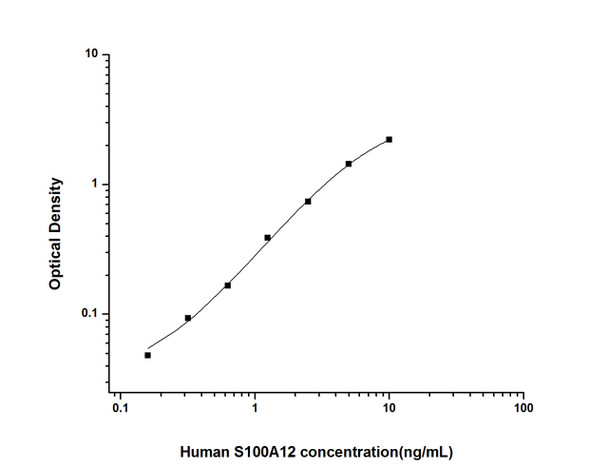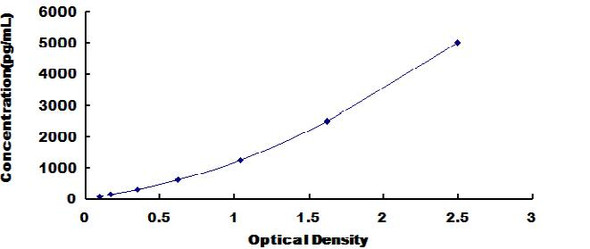Human Immunology ELISA Kits 1
Human S100A12 (S100 Calcium Binding Protein A12) ELISA Kit (HUES02349)
- SKU:
- HUES02349
- Product Type:
- ELISA Kit
- Size:
- 96 Assays
- Uniprot:
- P80511
- Sensitivity:
- 0.09ng/mL
- Range:
- 0.16-10ng/mL
- ELISA Type:
- Sandwich
- Synonyms:
- CAAF1, CAGC, CGRP, ENRAGE, MRP-6, MRP6, p6, Calgranulin C
- Reactivity:
- Human
- Sample Type:
- Serum, plasma and other biological fluids
- Research Area:
- Immunology
Description
| Assay type: | Sandwich |
| Format: | 96T |
| Assay time: | 4.5h |
| Reactivity: | Human |
| Detection Method: | Colormetric |
| Detection Range: | 0.16-10 ng/mL |
| Sensitivity: | 0.10 ng/mL |
| Sample Volume Required Per Well: | 100µL |
| Sample Type: | Serum, plasma and other biological fluids |
| Specificity: | This kit recognizes Human S100A12 in samples. No significant cross-reactivity or interference between Human S100A12 and analogues was observed. |
This ELISA kit uses Sandwich-ELISA as the method. The micro ELISA plate provided in this kit has been pre-coated with an antibody specific to Human S100A12. Standards or samples are added to the appropriate micro ELISA plate wells and combined with the specific antibody. Then a biotinylated detection antibody specific for Human S100A12 and Avidin-Horseradish Peroxidase (HRP) conjugate are added to each micro plate well successively and incubated. Free components are washed away. The substrate solution is added to each well. Only those wells that contain Human S100A12, biotinylated detection antibody and Avidin-HRP conjugate will appear blue in color. The enzyme-substrate reaction is terminated by adding Stop Solution and the color turns yellow. The optical density (OD) is measured spectrophotometrically at a wavelength of 450 nm ± 2 nm. The OD value is proportional to the concentration of Human S100A12. The concentration of Human S100A12 in samples can be calculated by comparing the OD of the samples to the standard curve.
| UniProt Protein Function: | S100A12: S100A12 is a calcium-, zinc- and copper-binding protein which plays a prominent role in the regulation of inflammatory processes and immune response. Its proinflammatory activity involves recruitment of leukocytes, promotion of cytokine and chemokine production, and regulation of leukocyte adhesion and migration. Acts as an alarmin or a danger associated molecular pattern (DAMP) molecule and stimulates innate immune cells via binding to receptor for advanced glycation endproducts (AGER). Binding to AGER activates the MAP-kinase and NF-kappa-B signaling pathways leading to production of proinflammatory cytokines and up-regulation of cell adhesion molecules ICAM1 and VCAM1. Acts as a monocyte and mast cell chemoattractant. Can stimulate mast cell degranulation and activation which generates chemokines, histamine and cytokines inducing further leukocyte recruitment to the sites of inflammation. Can inhibit the activity of matrix metalloproteinases; MMP2, MMP3 and MMP9 by chelating Zn(2+) from their active sites. Possesses filariacidal and filariastatic activity. Calcitermin possesses antifungal activity against C. albicans and is also active against E. coli and P. aeruginosa but not L. monocytogenes and S. aureus. Belongs to the S-101 family. |
| UniProt Protein Details: | Chromosomal Location of Human Ortholog: 1q21 Cellular Component: cytoskeleton; cytoplasm; extracellular region; plasma membrane; nucleus; cytosol Molecular Function:protein binding; RAGE receptor binding; copper ion binding; zinc ion binding; calcium ion binding Biological Process: neutrophil chemotaxis; positive regulation of MAP kinase activity; monocyte chemotaxis; positive regulation of I-kappaB kinase/NF-kappaB cascade; killing of cells of another organism; xenobiotic metabolic process; defense response to bacterium; innate immune response; inflammatory response; defense response to fungus; mast cell activation; cytokine secretion; activation of NF-kappaB transcription factor; positive regulation of inflammatory response |
| NCBI Summary: | The protein encoded by this gene is a member of the S100 family of proteins containing 2 EF-hand calcium-binding motifs. S100 proteins are localized in the cytoplasm and/or nucleus of a wide range of cells, and involved in the regulation of a number of cellular processes such as cell cycle progression and differentiation. S100 genes include at least 13 members which are located as a cluster on chromosome 1q21. This protein is proposed to be involved in specific calcium-dependent signal transduction pathways and its regulatory effect on cytoskeletal components may modulate various neutrophil activities. The protein includes an antimicrobial peptide which has antibacterial activity. [provided by RefSeq, Nov 2014] |
| UniProt Code: | P80511 |
| NCBI GenInfo Identifier: | 2507565 |
| NCBI Gene ID: | 6283 |
| NCBI Accession: | P80511. 2 |
| UniProt Related Accession: | P80511 |
| Molecular Weight: | |
| NCBI Full Name: | Protein S100-A12 |
| NCBI Synonym Full Names: | S100 calcium binding protein A12 |
| NCBI Official Symbol: | S100A12 |
| NCBI Official Synonym Symbols: | p6; CAGC; CGRP; MRP6; CAAF1; MRP-6; ENRAGE |
| NCBI Protein Information: | protein S100-A12 |
| UniProt Protein Name: | Protein S100-A12 |
| UniProt Synonym Protein Names: | CGRP; Calcium-binding protein in amniotic fluid 1; CAAF1; Calgranulin-C; CAGC; Extracellular newly identified RAGE-binding protein; EN-RAGE; Migration inhibitory factor-related protein 6; MRP-6; p6; Neutrophil S100 protein; S100 calcium-binding protein A12Calcitermin |
| UniProt Gene Name: | S100A12 |
| UniProt Entry Name: | S10AC_HUMAN |
As the OD values of the standard curve may vary according to the conditions of the actual assay performance (e. g. operator, pipetting technique, washing technique or temperature effects), the operator should establish a standard curve for each test. Typical standard curve and data is provided below for reference only.
| Concentration (ng/mL) | O.D | Average | Corrected |
| 10 | 2.233 2.285 | 2.259 | 2.205 |
| 5 | 1.468 1.524 | 1.496 | 1.442 |
| 2.5 | 0.797 0.783 | 0.79 | 0.736 |
| 1.25 | 0.438 0.448 | 0.443 | 0.389 |
| 0.63 | 0.232 0.208 | 0.22 | 0.166 |
| 0.32 | 0.159 0.135 | 0.147 | 0.093 |
| 0.16 | 0.097 0.107 | 0.102 | 0.048 |
| 0 | 0.05 0.058 | 0.054 | -- |
Precision
Intra-assay Precision (Precision within an assay): 3 samples with low, mid range and high level Human S100A12 were tested 20 times on one plate, respectively.
Inter-assay Precision (Precision between assays): 3 samples with low, mid range and high level Human S100A12 were tested on 3 different plates, 20 replicates in each plate.
| Intra-assay Precision | Inter-assay Precision | |||||
| Sample | 1 | 2 | 3 | 1 | 2 | 3 |
| n | 20 | 20 | 20 | 20 | 20 | 20 |
| Mean (ng/mL) | 0.49 | 1.08 | 4.12 | 0.48 | 1.06 | 3.86 |
| Standard deviation | 0.03 | 0.05 | 0.14 | 0.03 | 0.05 | 0.15 |
| C V (%) | 6.12 | 4.63 | 3.40 | 6.25 | 4.72 | 3.89 |
Recovery
The recovery of Human S100A12 spiked at three different levels in samples throughout the range of the assay was evaluated in various matrices.
| Sample Type | Range (%) | Average Recovery (%) |
| Serum (n=5) | 93-107 | 98 |
| EDTA plasma (n=5) | 91-107 | 98 |
| Cell culture media (n=5) | 89-102 | 95 |
Linearity
Samples were spiked with high concentrations of Human S100A12 and diluted with Reference Standard & Sample Diluent to produce samples with values within the range of the assay.
| Serum (n=5) | EDTA plasma (n=5) | Cell culture media (n=5) | ||
| 1:2 | Range (%) | 92-105 | 99-110 | 91-104 |
| Average (%) | 98 | 104 | 96 | |
| 1:4 | Range (%) | 91-104 | 85-100 | 84-96 |
| Average (%) | 98 | 92 | 89 | |
| 1:8 | Range (%) | 89-104 | 81-94 | 87-99 |
| Average (%) | 96 | 87 | 92 | |
| 1:16 | Range (%) | 85-100 | 84-95 | 87-99 |
| Average (%) | 92 | 89 | 94 |
An unopened kit can be stored at 4°C for 1 month. If the kit is not used within 1 month, store the items separately according to the following conditions once the kit is received.
| Item | Specifications | Storage |
| Micro ELISA Plate(Dismountable) | 8 wells ×12 strips | -20°C, 6 months |
| Reference Standard | 2 vials | |
| Concentrated Biotinylated Detection Ab (100×) | 1 vial, 120 µL | |
| Concentrated HRP Conjugate (100×) | 1 vial, 120 µL | -20°C(shading light), 6 months |
| Reference Standard & Sample Diluent | 1 vial, 20 mL | 4°C, 6 months |
| Biotinylated Detection Ab Diluent | 1 vial, 14 mL | |
| HRP Conjugate Diluent | 1 vial, 14 mL | |
| Concentrated Wash Buffer (25×) | 1 vial, 30 mL | |
| Substrate Reagent | 1 vial, 10 mL | 4°C(shading light) |
| Stop Solution | 1 vial, 10 mL | 4°C |
| Plate Sealer | 5 pieces | |
| Product Description | 1 copy | |
| Certificate of Analysis | 1 copy |
- Set standard, test sample and control (zero) wells on the pre-coated plate and record theirpositions. It is recommended to measure each standard and sample in duplicate. Note: addall solutions to the bottom of the plate wells while avoiding contact with the well walls. Ensuresolutions do not foam when adding to the wells.
- Aliquot 100 µL of standard solutions into the standard wells.
- Add 100 µL of Sample / Standard dilution buffer into the control (zero) well.
- Add 100 µL of properly diluted sample (serum, plasma, tissue homogenates and otherbiological fluids) into test sample wells.
- Cover the plate with the sealer provided in the kit and incubate for 90 min at 37 °C.
- Aspirate the liquid from each well, do not wash. Immediately add 100 µL of BiotinylatedDetection Ab working solution to each well. Cover the plate with a plate seal and gently mix. Incubate for 1 hour at 37 °C.
- Aspirate or decant the solution from the plate and add 350 µL of wash buffer to each welland incubate for 1-2 minutes at room temperature. Aspirate the solution from each well andclap the plate on absorbent filter paper to dry. Repeat this process 3 times. Note: a microplatewasher can be used in this step and other wash steps.
- Add 100 µL of HRP Conjugate working solution to each well. Cover with a plate seal andincubate for 30 min at 37 °C.
- Aspirate or decant the solution from each well. Repeat the wash process for five times asconducted in step 7.
- Add 90 µL of Substrate Reagent to each well. Cover with a new plate seal and incubate forapproximately 15 min at 37 °C. Protect the plate from light. Note: the reaction time can beshortened or extended according to the actual color change, but not by more than 30min.
- Add 50 µL of Stop Solution to each well. Note: Adding the stop solution should be done inthe same order as the substrate solution.
- Determine the optical density (OD value) of each well immediately with a microplate readerset at 450 nm.






